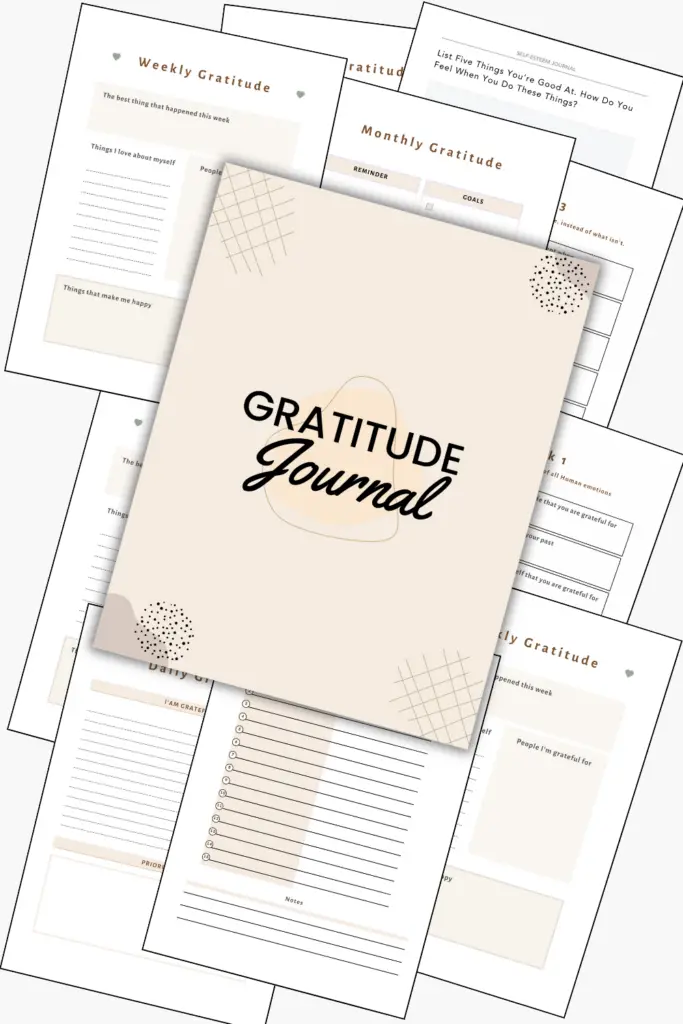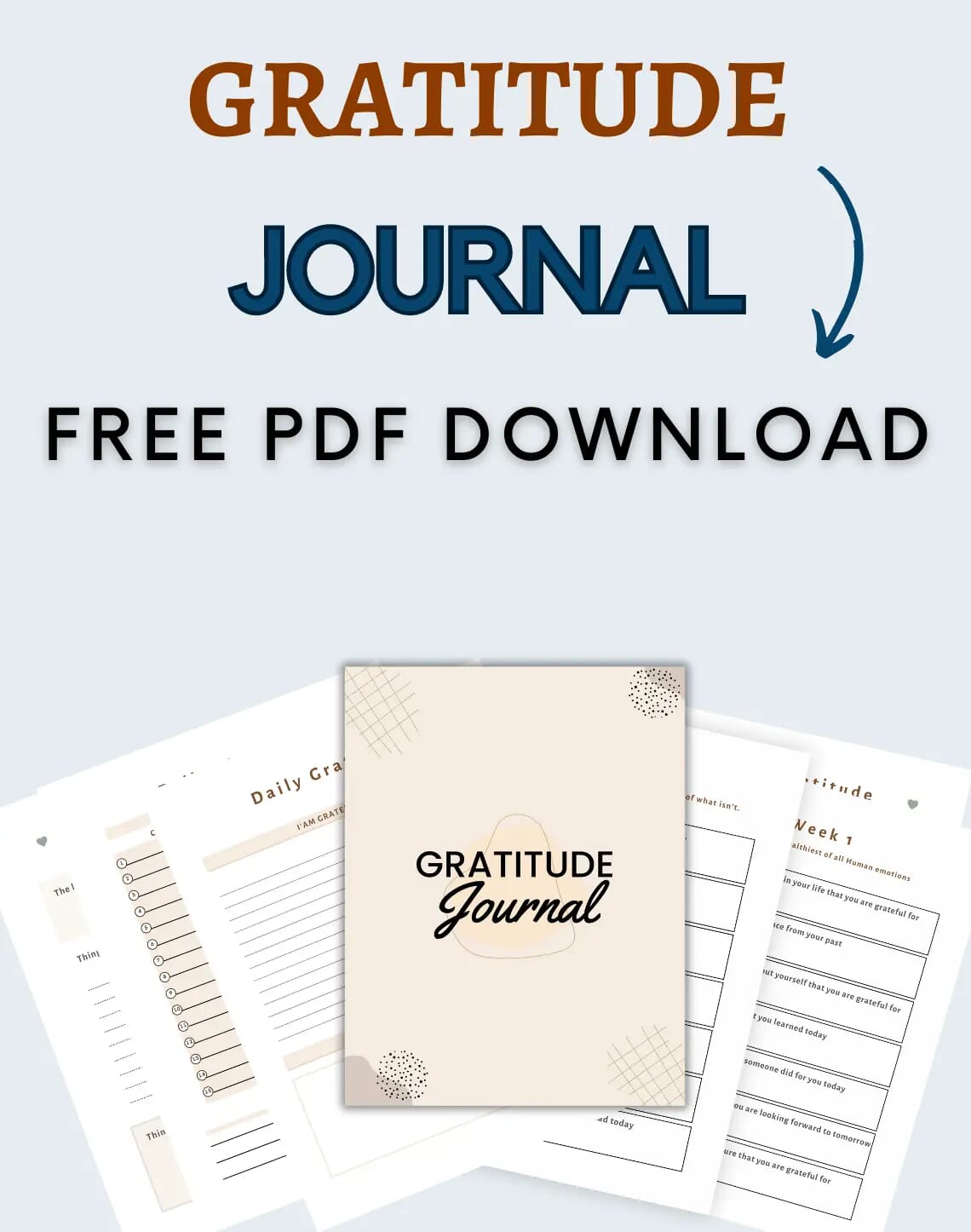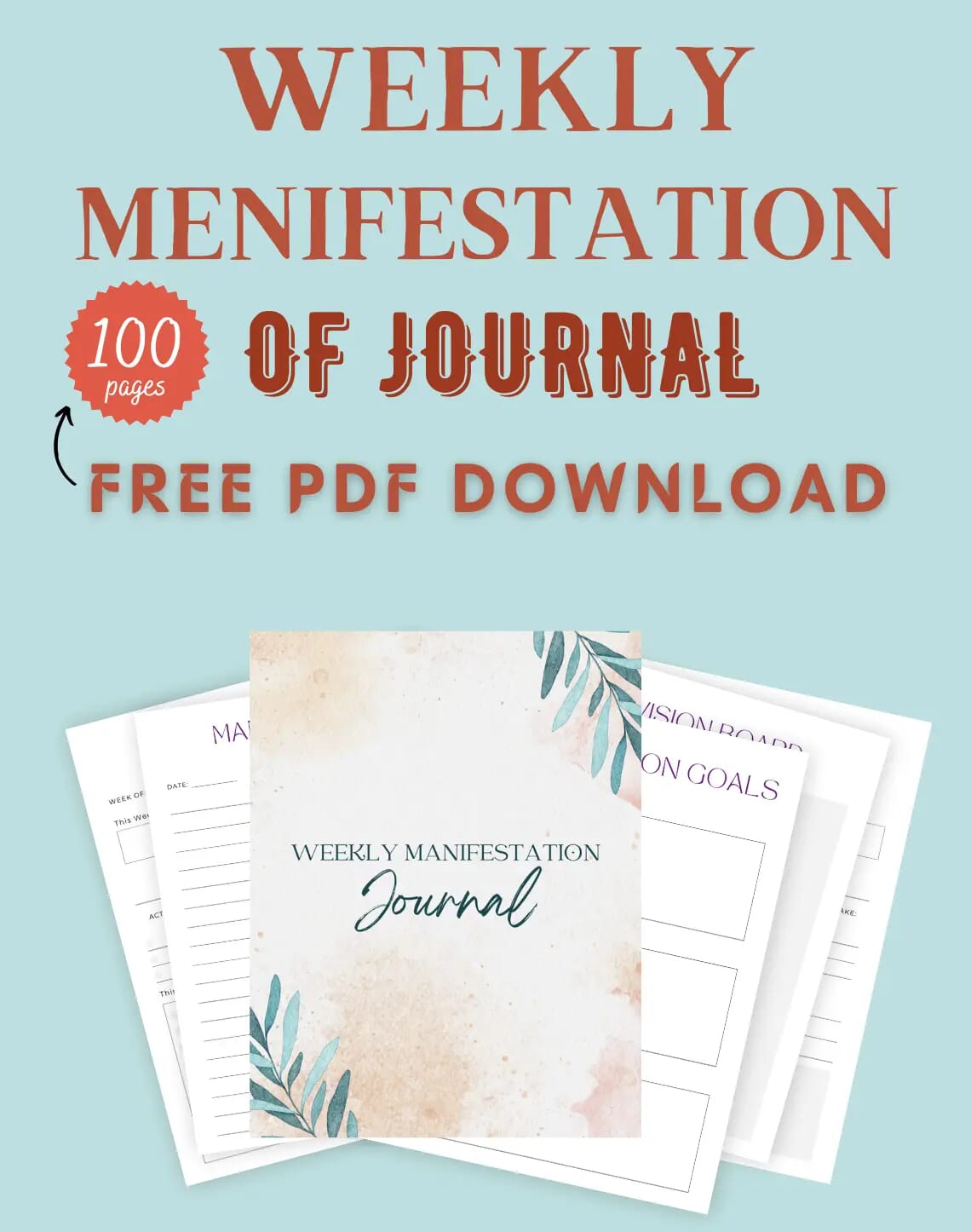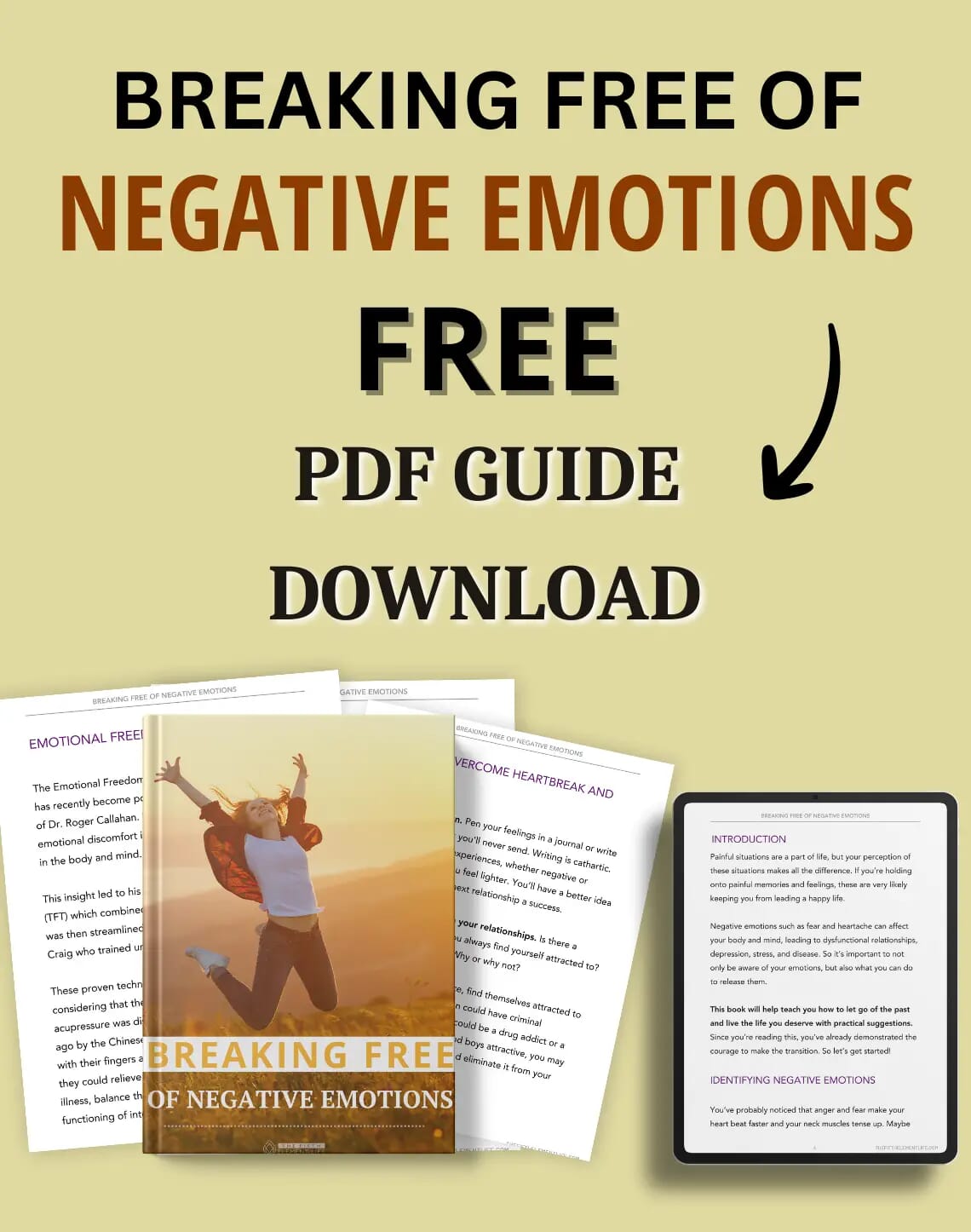Last Updated on May 25, 2023
Ultimate gratitude journal guide – According to studies, more people in today’s world suffer from some form of mental illness than ever before in history.
Why might this be?
Although there are likely many factors that contribute to this, I believe that a lot of human suffering nowadays derives from social media.
We’ve all been there, we’re scrolling through Instagram and photo after photo displays an array of photos depicting perfect lives- Sara is relaxing on the beach in Cuba and Rachel just got engaged.
You inevitably begin comparing yourself with others and as a result become discouraged and disappointed with your own life.
The problem with today’s world is that we are constantly connected and exposed to new information that we hardly have a moment to really appreciate the present moment and the blessings that are right in front of us.
Trust me, I’ve also fallen victim to this. Even now I see all of my friends getting married and buying homes. Meanwhile, I’m still single, living with my landlady and an exchange student (don’t get me wrong, they’re both really nice).

The idea I want to emphasize, and from which I will be exploring in today’s article, is gratitude.
If you grew up going to church every Sunday like me, this concept is something you’re likely all too familiar with.
According to the dictionary, gratitude is “the quality of being thankful”. It seems simple, but to truly manifest this type of mindset, especially in a chaotic society that is never satisfied, is not easy.
But cultivating this perspective doesn’t have to be done without help. In fact, using a tool, such as journaling, will aid you in experiencing gratitude to the fullest and allow you to make a positive change in your life.
If you want to show more appreciation in your life and be thankful for the beauty that is all around us, I highly recommend gratitude journaling.
And if you’re not sure what that entails exactly, don’t worry, because this article is all about how to manifest gratitude through writing!
Choose A Journal
As you may have guessed, the first logical step to starting a gratitude journal is to obtain a journal.
This may seem fairly straight forward, but there are some things you may want to consider when choosing the right one for you.
Here’s what you need to know.
The first question you should consider is whether you want a physical or digital journal. I personally like a paper journal as I feel like the experience is more satisfying, however, an online like one is a great alternative for those who enjoy the convenience of a computer.
While you’re searching for the right journal for you, you may notice that some books will contain what is called “prompts”. Prompts are questions or statements that provide you with ideas and inspiration for the content of your writing (for more info on this, make sure to check out section 4 below: Start With Journal Prompts).
If you’re a visual person, another component you may want to consider is the physical aspect of the journal. For example, if you are a person who tends toward extensive visual stimulation, you may choose a journal with bright and bold colors or illustrations.
I personally like to choose journals with designs that are calming and peaceful, such as a picture of the ocean or a flower in soft hues.
It’s important to remember that you don’t need anything fancy or expensive to start your gratitude journey. As long as it resonates with you and gets you excited about writing, you’ve made the right choice.
- Understand The Benefits Of Journaling
If you aren’t yet convinced to start journaling, perhaps learning about the vast array of benefits on your mental and emotional wellbeing will change your mind.
Here are some of the benefits of journaling and gratitude journaling:
- Reduces stress: As a person with a proclivity toward being anxious, stress and its effects are like second nature to me. Looking back, I can definitely say that a significant contributor to my stress was feeling discontent with my life. I had moved to Europe but wasn’t moving forward career wise. Once I began focusing on the positives in my life, like realizing that having the opportunity to live abroad at all was incredible itself, my mindset changed. My anxiety began to diminish and I was able to manage future challenges with greater ease.
- Improves mental clarity: Journaling can help release mental clutter by allowing you to unload all of your thoughts and emotions onto the page. By giving yourself permission to write without any judgment or filter, you can clear your mind and gain greater clarity.
- Boosts creativity: Journaling is a skill that takes time to develop.When you engage in this type of activity, you are working on this skill and improving your ability to think critically. It forces you to explore different outcomes, which will inevitably make you more innovative and creative.
- Enhances self-awareness: when you analyze each day (on a regular basis) you will start to notice certain patterns and habits in your life. This will ultimately make you more aware of yourself and recurrent behaviors, thoughts and feelings. It will also help you to identify the things you are grateful for.
- Improves relationships: when you start to appreciate the people around you more, you can develop more meaningful connections with them. As humans, we are social beings, and when we have healthy relationships with others we will also see positive change in other areas of our lives. I, for one, have an amazing support system that makes me truly grateful for the life I have in Madrid.
The Science Behind It
When I started going to therapy, one of the first things that was assigned to me to address my anxiety was journaling.
Over the last few years, the benefits of journaling have become more and more known, which is why therapists have begun using it as a form of treating mental health issues.
If you think about it, it makes sense. When you engage in journaling, you are not only reflecting on your thoughts and emotions. When you become aware of these feelings, you can then find productive methods of regulating them.
For example, when I began writing about my anxiety, I became more self-aware and was able to identify patterns in my daily life that weren’t serving me.
In addition to greater self-awareness and improved memory, journaling has also been connected with decreasing levels of stress as well as improving your immune system.
For me, when I have a lot of negative thoughts in my mind at once, it can feel overwhelming. When I release these thoughts onto the pages of my journal, it feels like a huge weight has been lifted off my shoulders.
According to studies, this is a result of your cortisol levels decreasing (this is the hormone that is associated with stress).
As you can see, journaling is good for both your mental and physical health!
3. When To Journal
As a person with a very busy life, I know how difficult it can sometimes be to find time for yourself.
Ultimately, the best time to journal is simply when it works best for you or when you’re feeling particularly inspired.
I prefer to journal in the morning as this allows me to start my day on a positive note, however many people may opt to journal in the evening as a way to reflect on their day and wind down before bed.
If you’re having trouble figuring out when the best time for you is to journal, here are some factors to consider:
RELATED: 115 Of Eckhart Tolle’s Most Influential & Inspiring Quotes To Find Purpose & Meaning
- Time of day: knowing when you should journal totally depends on your daily routine. I tend to have a pretty busy social life in the evening, so I personally like to write in the morning. However, if you have kids or work early shifts, the evening may be the best time for you.
- Energy levels: when you are journaling you want to ensure you have the energy to self-reflect and write effectively (if you’re tired, you may get frustrated and discouraged more easily). See what time of the day you have the most energy and write then. For me, it’s in the morning!
- Purpose: it’s also good to establish exactly why you want to start journaling. For example, if you find you wake up in a negative frame of mind, you might want to journal in the morning to put yourself in a good mood for the day ahead. On the other hand, if you prefer to reflect on the day’s events, the evening is likely better for you. As a person who tends to wake up with anxiety, I definitely prefer the morning.
Regardless of whether it’s in the morning, afternoon or evening, you can’t go wrong.
4. Start With Journal Prompts

Journal prompts can be a great way to get started with gratitude journaling or to add some variety to your practice.
Here are some examples of journal prompts you can use for gratitude journaling:
- What are three things you’re grateful for today? Write about why these things are important to you and how they make you feel.
- Think about someone in your life who has made a positive impact on you. Write about why you’re grateful for this person and how they’ve influenced your life.
- Write about a time when you overcame a challenge or hardship. Focus on the lessons you learned from the experience and how it helped you grow as a person.
- Reflect on the people in your life who support and encourage you. Write about why you’re grateful for these individuals and how they’ve helped you become a better person.
- Write about a small pleasure or joy in your life, such as your morning coffee or a favorite book. Reflect on why you’re grateful for these small things and how they bring happiness to your life.
- Think about a moment in your life when you felt truly alive and present. Write about why this moment was special to you and how it made you feel.
- Write about a goal or dream that you’re working towards. Focus on the progress you’ve made so far and express gratitude for the opportunities and resources that have helped you along the way.
These prompts are just a few examples of how you can incorporate gratitude into your journaling practice. Use them as a starting point, and feel free to come up with your own prompts that resonate with you personally.
For an extensive list of gratitude journal prompts, make sure to check out this article here!
5. Finding New Angles
After journaling for a while, it can be difficult to come up with new topics and perspectives (as a person who has been journaling since they were a child, I get this).
Here are some tips on discovering new angles when you want to journal, but find you’re a little stuck on what to talk about.
- Focus on the present moment: Rather than reflecting on past events or future possibilities, focus on what is happening in the present moment. Take note of things that bring you joy, whether it’s a beautiful sunrise, a delicious meal, or a kind gesture from a friend.
- Look for the positive in challenging situations: When things get tough, it can be easy to focus on the negative. However, there is always something positive to be found, no matter how small. Try to find the silver lining in challenging situations and write about it in your gratitude journal.
- Try a different perspective: Take a break from writing from your own perspective and try writing from someone else’s point of view. For example, you could write about what your pet is grateful for, or what your best friend appreciates about you.
- Use prompts or exercises: There are many gratitude journaling prompts and exercises available online or in books. These can help you explore different aspects of gratitude and spark new ideas for topics.
Here are some topic examples for gratitude journaling:
- Write about someone in your life who has made a positive impact on you and why you are grateful for them.
- List three things that you take for granted and write about why you are grateful for them.
- Write about a challenge you faced recently and how you were able to find something positive in the situation.
- Write about a place that brings you joy and why you are grateful for it.
- Write a letter of gratitude to someone who has helped you in the past, expressing your appreciation for their support.
Remember, the key to gratitude journaling is to focus on the positive and cultivate a sense of appreciation for the good things in your life.
6. Get Creative!
If you’re like me and have a creative flare, there are many ways to get creative with journaling!
Here are some ideas:
- Use different mediums: Instead of just writing, try using different materials like paint, markers, or even collages to express your thoughts and feelings. You can use images and color to represent your emotions and experiences.
- Try different prompts: Mix up your journaling routine by trying different prompts or writing exercises. You can find inspiration online, in books, or by simply observing the world around you. Some prompts could be: “What makes me happy?”, “What are my goals for the week/month/year?”, “What am I grateful for?”, or “What did I learn today?”.
- Incorporate mindfulness: Practice mindfulness by focusing on the present moment and your physical sensations. Write down what you’re feeling and experiencing, and notice any thoughts that come up. You can also try meditation or deep breathing exercises before or after journaling.
- Write letters: Write a letter to yourself, a loved one, or even a stranger. You can express your thoughts and feelings, share advice, or just write about your day.
- Create a scrapbook: Use your journal as a scrapbook by adding photos, ticket stubs, or other memorabilia that represent your experiences.
Remember, journaling is a personal and creative process, so don’t be afraid to experiment and find what works best for you!
And if you really want to get your creative juices flowing, make sure to check out our article on visual journaling.
RELATED: 119 Of Bob Proctor’s Most Influential & Inspiring Quotes To Create The Life You Desire
7. Incorporate Quotes

“…it is not joy that makes us grateful; it is gratitude that makes us joyful.” – David Steindl-Rast
Incorporating quotes into gratitude journaling can add inspiration and depth to your practice.
I personally find great inspiration from the wise words of others, especially when they remind me of the power of gratitude.
Here are some ways to add quotes into your journal:
- Choose a quote that resonates with you: Look for quotes about gratitude that you find meaningful or inspiring. Write down the quote in your journal, and reflect on how it relates to your life and what you’re grateful for.
- Use a quote as a writing prompt: Use a gratitude quote as a starting point for your journal entry. Write about what the quote means to you, and how you can apply its message to your life.
- Make a gratitude list inspired by a quote: Use a gratitude quote to spark a list of things you’re grateful for. For example, if the quote is “Gratitude turns what we have into enough,” you could list all the things in your life that you’re grateful for, and reflect on how they make your life “enough.”
- Reflect on a quote at the end of your journaling session: Choose a gratitude quote to reflect on at the end of your journaling session. Write about how the quote made you feel, and how you can carry its message with you throughout the day.
For a list of over 100 gratitude quotes, make sure to check out this article.
8. Check In With Yourself
Checking in with yourself during the journaling process is an important way to track your progress, reflect on your experiences, and deepen your self-awareness.
Here are some tips on how to do it:
- Schedule regular journaling sessions: Set aside time each day or week for journaling. Consistency is key, and scheduling regular sessions can help you establish a habit of self-reflection.
- Reflect on past entries: Periodically go back and read through your past journal entries. Notice any patterns or recurring themes, and reflect on how you’ve grown or changed over time.
- Ask yourself questions: Use your journal as a tool for self-inquiry. Ask yourself questions like “How am I feeling today?”, “What have I learned recently?”, or “What am I grateful for?” Write down your answers and reflect on them.
- Practice mindfulness: Before you begin journaling, take a moment to check in with yourself. Take a few deep breaths, and notice any physical sensations or emotions that you’re experiencing. Write down your observations and reflect on how you’re feeling.
- Use prompts to guide your reflection: Try using prompts or writing exercises to guide your reflection. For example, you could write about a challenging situation you faced recently, and reflect on how you responded to it, what you learned from it, and what you would do differently next time.
Gratitude journaling can be a powerful tool for personal growth and self-reflection, but it can also have a positive impact on others.
Since I have been gratitude journaling, I find myself being significantly more empathetic towards others as well as wanting to make a more positive impact on the world (such as giving to charity).
Here are some ways to translate what you’ve learned through gratitude journaling to others:
- Share your insights: Talk to others about what you’ve learned through your gratitude journaling practice. Share your insights, experiences, and the positive changes you’ve noticed in your life. Encourage them to try gratitude journaling themselves and share their own experiences with you.
- Write gratitude letters: Use your gratitude journaling practice as inspiration to write letters of appreciation to the people in your life who have made a positive impact on you. Share specific examples of how they have made a difference, and express your gratitude for their presence in your life.
- Practice random acts of kindness: Use your gratitude practice as motivation to perform random acts of kindness for others. Hold the door open for someone, leave a kind note for a coworker, or offer to help a neighbor with their groceries. These small acts of kindness can have a big impact on others and help spread positivity.
- Volunteer or donate to charity: Use your gratitude practice to motivate you to give back to your community. Volunteer your time or donate to a charity that you care about. Helping others can be a great way to cultivate gratitude and appreciation in your own life.
- Use other techniques/tools: accompanying your journaling practice with other tools such as mandala coloring books and crystals can help to make the effects more powerful. Here are some methods you can try:
RELATED: 155 Of Neville Goddard’s Most Influential & Inspiring Quotes To Shape Your Own Reality
Mandala coloring books:
Mandala coloring books are a form of art therapy that involves coloring intricate designs. Coloring can help you relax and focus on the present moment.
The circular patterns of mandalas can also be meditative and help you tap into your inner wisdom. Coloring mandalas can be a great way to unwind after a long day and clear your mind.
Crystals and crystal jewelry:
Crystals are believed to have healing properties that can help balance your energy and promote well-being. Each crystal is thought to have its own unique properties, so it’s important to choose a crystal that resonates with you.
For example, amethyst is thought to promote relaxation and reduce stress, while rose quartz is believed to promote love and compassion. You can hold a crystal while you meditate or color, or wear crystal jewelry throughout the day as a reminder to stay grounded and grateful.

Music:
Music can be a powerful tool for promoting relaxation, reducing stress, and boosting your mood. Choose music that inspires you and makes you feel good.
You can listen to music while you meditate, color, or write in your gratitude journal.
Combining these practices can help you create a powerful and effective gratitude practice that can help you feel more positive, calm, and centered.
Remember, incorporating tools such as gratitude journaling, mandala coloring books, music, and crystals into your self-help and spiritual practice can be a powerful way to connect with yourself and the world around you.
By focusing on gratitude, you can shift your perspective towards the positive and cultivate a sense of mindfulness and appreciation for the present moment.
Pairing this with the meditative practice of coloring mandalas, listening to uplifting music, or holding crystals can help you tap into a deeper sense of peace and connection.
So, why not give these practices a try and see where they lead you on your path of self-help and spirituality?
You may be surprised at the transformation that awaits you.
Frequently Asked Questions
What is the spiritual power of gratitude?
The spiritual power of gratitude lies in its ability to deepen one’s connection with the divine, foster mindfulness and presence, cultivate humility and surrender, facilitate personal transformation and growth, nurture a sense of interconnectedness, and evoke a deep sense of gratitude for the abundance of life. It serves as a powerful practice for individuals seeking to align with their spiritual nature and experience a deeper sense of purpose, peace, and fulfillment.
What is gratitude vision?
“Gratitude vision” is not a widely recognized term or concept. However, it could refer to a mindset or perspective that involves seeing the world through the lens of gratitude. By adopting a gratitude vision, individuals cultivate a mindset that emphasizes gratitude as a way of perceiving and experiencing the world. This perspective can lead to increased positivity, contentment, and overall well-being.
How gratitude changes the personality?
Practicing gratitude can bring about significant changes in a person’s personality. It cultivates positivity, resilience, empathy, self-esteem, and stronger relationships, ultimately leading to enhanced well-being and a more fulfilling life.
Continue Reading 👉: 103 Phenomenal “Focus On What You Can Control” Quotes To Live A Rich And Rewarding Life
- 49 Unique Self-Care Kit Ideas For Your Well-Being - February 14, 2024
- 85 Exciting And Encouraging Quotes About Trying New Things In Life To Inspire That First Step - February 14, 2024
- 125 Inspiring You Are Amazing Quotes For Yourself And The Special People In Your Life - February 14, 2024










